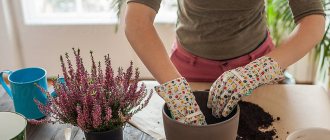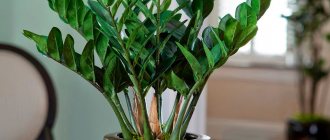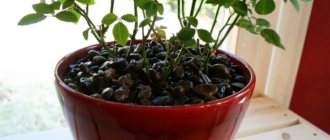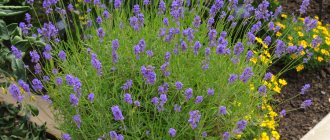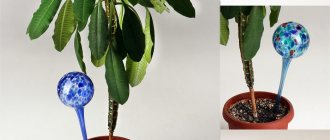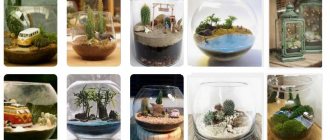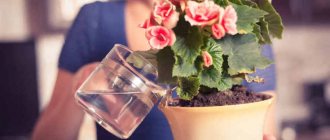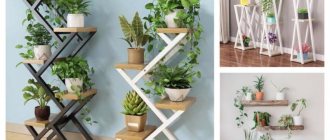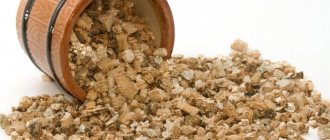How to care for a plant in a peat substrate?
The process of caring for plants in a peat substrate is somewhat different from caring for plants in ordinary soil.
Let's look at the main features that should be remembered if you have plants planted in a peat substrate. Large plants in a tub are difficult to replant, so they use partial replacement of the top layer of substrate. To do this, carefully, so as not to damage the roots, remove the upper part of the old substrate and add fresh one. If the old substrate is leached due to watering with hard water, an acidic substrate is added to the top layer. This will allow you to slightly correct (acidify) the bottom layer over time.
Most problems when growing plants in peat substrates arise from improper watering of the substrate. Water as needed, taking into account the needs of the plants, avoiding overdrying of the substrate and stagnation of water in the pan. There must be drainage holes in the bottom of the pot. Of the huge variety of indoor plants, only 1-2% like excessively high soil moisture (Scirpus cernuus, Pogonatherum, Cyper involucratus).
Some plants, such as Cyclamen and Uzumbara violet, do not like water getting on their leaves and buds. Therefore, they need to be watered from below.
For watering, you must use warm, soft, preferably rainwater. Tap water must be defended. To soften and simultaneously acidify the water, you can use high-moor peat (0.5 liters of high-moor peat or Sour substrate leave in a bucket of water for at least 24 hours, you can pass it through a layer of peat several times).
Issues of the quality of irrigation water are important due to the fact that too high a concentration of salts can lead to the death of plants from vascular fungal diseases.
Do not allow the substrate to dry out; if this happens, to re-saturate it with water, lower the pot into a vessel with water and hold until air bubbles come out.
If there is excessive moisture in a substrate rich in organic matter, fungal sciarid gnats or springtails (forktails, podars) can appear. Mostly they fly in from the street. In small numbers, these insects do not cause harm to plants, since they feed on dead plant debris, but the larvae can damage young plants and seedlings. Water the plants with an insecticide solution and keep them in drier conditions.
During growth, the plant consumes nutrients from the soil. To maintain its growth, it is necessary to constantly replenish the supply of nutrients. The best way is to fertilize with irrigation water. When choosing the appropriate fertilizer, pay attention to its quality. Fertilizing should be carried out with liquid complex chlorine-free mineral or organic fertilizers as needed. The first feeding is carried out 5-6 weeks after transplantation.
For very young and sick plants and cuttings, excess nitrogen, especially ammonia, is harmful. When preparing a fertilizer solution, take into account the permissible total concentration of salts, which, taking into account the salts present in irrigation water, should not exceed the above values.
Long-acting fertilizers, so-called, make it easier to care for plants. long-lasting fertilizers (granules, sticks). Use only sterile organic fertilizers.
Source
Why ready-made peat soil is actually unsuitable for indoor flowers
Indoor plants, unlike garden plants, develop in a limited volume of substrate, so the selection of soil must be taken seriously. Among the ready-made compositions, soil mixtures based on high-moor peat are most often found on sale. It is used to make lightweight transport soil in which plants are delivered to the shelves of flower shops. Such peat quickly loses fertility after extraction, is not rich in minerals and has a number of other disadvantages.
What kind of soil do plants need?
Seedling boxes and pots are nurseries for plants. Like all babies, young plants need favorable conditions for healthy growth and development.
Young plants need favorable conditions for growth
In order for a seed to swell and germinate, in addition to the optimal temperature, a certain humidity is also required. This means that the soil should absorb well and retain moisture for a long time, but at the same time be loose and airy enough so that the seed does not “suffocate” and rot. In addition, in dense soil it will not be easy for young roots to break through.
Since seedlings develop in a limited volume of soil, the soil must contain enough nutrients for a successful start. Let’s not forget about the pH balance: if the soil acidity is incorrect, the plant will not be able to fully absorb some elements and will lag in growth. The soil reaction should be close to neutral - pH 6-7.
Stores are full of a variety of soils. What should a simple summer resident choose?
Poor wettability
After complete drying, the peat will under no circumstances be able to regain its original moisture and volume. This is due to the fact that when peat dries out, it changes its qualities and is no longer able to restore them in the future. Therefore, if the flower is not watered on time, next time the water will simply pass through the substrate without stopping. If this problem is not solved immediately, the flower will die. If you notice an immediate leakage of water from the drainage holes when watering, change your tactics. The earthen ball with the plant must be removed from the pot and placed in a basin of water. In the future, it is recommended to change the substrate.
Ready-made peat soil is simple and easy to use, it is cheap and easy to find even in supermarkets. But due to the natural properties of peat, it is not suitable for indoor flowers. To avoid disappointment, purchase soil mixtures in which high-moor peat is an additional rather than a dominant component. Check the recommendations for the composition of the substrate specifically for your plant. If necessary, dilute store-bought soil with additional ingredients - sand, vermiculite, humus.
Source
Universal soil: what plants is it suitable for?
A beautiful, neat garden, vegetable garden and even a home flower garden is not only the pride of any owner, but also a huge amount of effort and painstaking work. As well as the correct selection of soil, fertilizers, regular and comprehensive care. In this matter, every detail matters, this is especially true in relation to the selection of soil. The final result of your efforts, the health, appearance and fertility of the plant will depend on it, along with light, water and carbon dioxide. Today we’ll talk about universal soil, what it is and when the use of such soil will benefit your plants.
Why is soil called universal?
When purchasing soil, you need to consider several characteristics:
The biggest and most common mistake in caring for plantings is the idea that a plant can take root in absolutely any soil. But in fact, it turns out that sterility, inconvenience, unknown or inappropriate composition, nutritional value, “richness” of the soil are good reasons to give preference to store-bought, ready-made products. Therefore, if you are not sure that you can handle it yourself, give preference to universal, ready-made substrates. Such soil allows you to significantly save energy and time, provides adequate and high-quality conditions for all plants, and guarantees their growth in an ideal environment for them. Of course, such mixtures are expensive. But believe me, as a rule, such costs are more than compensated for by a rich harvest, powerful flowering, and longevity of the plant.
A single, complex soil mixture is considered universal, since it is suitable for all groups and types of plants, and its composition is averaged in its characteristics and indicators. At the same time, even very fastidious and demanding crops take root well in such soil.
Separately, I would like to talk about creating a universal soil with your own hands. It is extremely difficult to create the right soil mixture for your plants yourself, so professionals do not advise taking on this task. You run the risk of not only encountering problems with soil treatment and incorrect division of proportions, but you will also be forced to spend a lot of money. Good, universal soil includes a large number of components: from peat, turf soil to sand and humus. This task is not always within the power of even very experienced and intelligent gardeners.
Basic composition of ready-made soils
The basis of most soils is a mixture of high-moor and low-lying peat. What is the difference between these components?
High peat has high moisture capacity, looseness and porosity and is responsible for supplying the roots with air and water. At the same time, there is practically no organic matter available to plants. The now fashionable coconut substrate has the same properties. But we have a lot of peat bogs in our country, but somehow things didn’t work out with coconuts - so peat products are cheaper and easier to find.
Lowland peat enriches the soil with nutritious organic matter, but has low air permeability. Thus, we can conclude that both types of peat in the mixture complement each other.
Do not forget that high-moor peat has high acidity. Among plants, there are, of course, lovers of “sourness,” but most vegetable and flower crops are not one of them. Therefore, the composition must necessarily contain a deoxidizing agent - dolomite flour , lime or ash . In industrially produced mixtures, dolomite is usually used to bring the pH to 6-7.
“Krepysh” from “Fasko” contains everything that is necessary for seedlings, the pH is normal
To increase looseness, so that after numerous waterings the peat does not become compacted and caking, coarse river sand , agroperlite or vermiculite .
The standard peat mixture, of course, is rich in organic matter, but young lichens are not able to fully absorb the necessary substances from it. Therefore, you need to either constantly feed them, or purchase soil that already contains a starter set of mineral fertilizers .
Pros and cons of universal primer
Universal soil has a number of significant advantages over ordinary soil. The advantages of such an admixture include:
Another important advantage is that universal primer is convenient to use; it does not require active or additional processing. Caring for plants in such soil is simple and ergonomic, and does not take much time. The universal soil stimulates well the development and active growth of the root system and restores the decorative properties of plants. With its help, you can bring weak, sickly plants back to life. But even despite the significant and significant advantages, universal soil also has its certain disadvantages. Lack of care, problems with growing crops and other shortcomings also arise in this case.
In order not to make a mistake with your purchase and thereby not spoil the plants, use the tips on choosing a universal soil.
Universal mixture
A soil mixture with a universal composition is suitable for most indoor plants. Succulents, desert cacti and young plants with insufficiently strong root systems feel best in such soil. To prepare an ideal light soil mixture use:
- Peat or peat soil – 2 parts. Only well-decomposed, weathered peat is suitable for flowers, so it is not recommended to buy it fresh; it is better to choose it in a store.
- Garden soil – 1.5 shares. Any fertile soil from a flower bed, vegetable garden or other available area will do. The earth is broken up into small fractions, removed from roots and debris, and sifted.
- Sand – 1.5 shares. For flowers, only well-washed, light and draining river sand is recommended. Construction material should not be used under any circumstances.
- Deciduous humus - 0.5 parts. Half-decomposed leaves from various tree species are harvested in the fall, when the foliage falls. Collection is not recommended along roads; foliage of oak, poplar, willow, and chestnut is not used for flowers.
- Vermiculite or crushed charcoal – 0.1-0.2 parts. Such additives make the substrate more loose and moisture-absorbing, which allows the soil not to dry out and become lumpy, and the roots of young plants not to be damaged.
Scope of application of universal primer
Universal primer can be used effectively without risk or problems:
Universal soil is an excellent solution and choice for planting various crops and plants. It promotes their rapid germination and development. It also ensures their complete, balanced nutrition, health, and impressive appearance. At the same time, such soil guarantees rapid adaptation of seeds and their easy replanting. Also, universal soil improves fertility and yield, quality and taste of fruits. It accelerates the ripening process, restores the natural process of soil biocenosis, and ensures rapid growth of crops. Does not harm the environment and humans, does not contain chemicals, GMOs, or harmful additives.
Universal primer is stored in original and sealed packaging in dry, well-ventilated areas. It is prohibited to store the mixture near food, feed, or other types of fertilizers. The shelf life of universal primer depends on the manufacturer. Most often, the indicator does not exceed 2-3 years from the date of manufacture.
It's time to draw conclusions: universal soil is a reasonable and necessary purchase, which will greatly facilitate and simplify the life of a gardener and gardener, a connoisseur of well-groomed, stylish flower beds and flower beds.
Source
How to use peat correctly
Peat is a mixture of semi-decomposed plant remains under conditions of excess moisture. It is one of the most popular organic fertilizers, especially among beginning gardeners.
They try to purchase as much of it as possible and immediately apply it to the soil or use it for growing seedlings. But they often fail, because... plants fertilized with peat alone do not grow well enough, and seedlings grown in pots filled with peat alone often die for some reason. To avoid these failures, you need to know what type of peat can be used, where and how.
As you know, there are different types of peat - highland, lowland and transitional. You should definitely be interested in this when purchasing it. They are easy to distinguish from each other, because... they have completely different colors.
Lowland peat can be used to add to the soil without composting. But before adding it to the soil, it is well crushed and “weathered” in heaps for at least six months. But this is not the best option, since the conversion of the nitrogen contained in it into a form convenient for plants will occur slowly.
That is why the use of even lowland peat in its pure form as a fertilizer is ineffective and sometimes harmful, since dry peat, when applied to the soil, absorbs the moisture needed by plants from the soil.
As can be seen from all that has been said, adding unprepared peat to the soil is of little use, because it potentially contains only nitrogen in abundance, but even in low-lying, well-decomposed peat, it is practically inaccessible to plants.
In the first years after being added to the soil, such peat only increases the absorption capacity of the soil and improves its air regime. Therefore, we must remember that if the soil in the garden is well cultivated, loose and fertile, then adding such unprepared peat to it is practically useless.
It’s another matter if there is little organic matter in the soil, especially if it is heavy, clayey, floating or, conversely, sandy or light sandy loam soil. In this case, with the help of peat, you can significantly improve the physical properties and structure of clay soil, make it more loose, water- and moisture-permeable, and in sandy soil, on the contrary, significantly increase its moisture capacity.
To increase the humus content on soddy-podzolic soil by 1%, you need to add 2-3 buckets of peat per 1 sq.m. In this case, it is better to scatter it over the surface of the soil in the fall, and in the spring, gradually mix the surface layer with peat. Since peat retains all available substances well, it can be applied to the soil even in winter directly on the snow. In addition, peat is usually relatively cheap.
Some gardeners sometimes use fresh lowland peat with the addition of garden soil to create bulk beds for growing cucumbers and zucchini, planting seedlings in holes completely filled with good humus.
By the time the plant roots grow beyond the boundaries of such a hole, the low-lying peat will have sufficiently lost its negative qualities. When constructing such beds, wood ash is added to the peat, 2 cups per bucket of peat and ordinary garden soil.
But, of course, it is much more useful to cover a pile of low-lying peat with film and keep it like that for 3-4 months, occasionally watering it with water, diluted slurry or herbal infusions. During this time, the peat will “ripen”, and it will already be “truly” useful peat.
And acidic high-moor peat in its pure form cannot be added to the soil and used for growing seedlings at all. This type of peat is mainly used for animal bedding. It needs extensive composting before being added to the soil. It is used for the preparation of peat manure, peat fecal, peat phosphorite, peat ash and other composts.
Source
How to improve ready-made soil for indoor plants
How to improve ready-made soil for indoor plants, what additives affect its quality? Let's consider the main components of soil mixtures.
- Peat is the main component of soil mixtures
- The most affordable additives for ready-made soil based on peat Biohumus
- Charcoal
- Sphagnum moss
- Hydrogel
- Perlite and vermiculite
Peat is the main component of soil mixtures
Peat, the main component of ready-made mixtures, is very moisture-intensive. But, as it dries, the substrate “shrinks” and lags behind the walls of the pot. Attempts to “spill” the soil do not entail much success: water rolls over its surface without being absorbed. The only way out, if it comes to this, is to immerse the pot with the plant in a bowl of water for a couple of hours.
In the photo: Ready-made high-moor peat
How to prevent a recurrence of such a situation? There are several options here. You can carefully monitor the regularity of watering, and everything will be fine. But if you are not one of the disciplined people who do everything on time and according to the rules, you can try different additives to the finished mixture. Which ones exactly and why?
The most affordable additives for ready-made peat-based soil
Let's return to the composition of ready-made soils. The vast majority of ready-made mixtures, the assortment of which is amazing in abundance, consists of one or more types of peat, deoxidizing additives, mineral fertilizers, humic substances, sand and agroperlite. The most accessible and simplest ways to improve the finished substrate is to add appropriate additives:
- vermicompost
- charcoal
- sphagnum moss
- hydrogel
- perlite and vermiculite
Vermicompost. The properties of such a mixture can be significantly improved by adding humus, but here we again return to the need to independently harvest the soil. If this is not possible, you can look for mixtures on sale labeled “biohumus” or “made with worms,” usually Californian ones. Peat will also predominate in such mixtures, but in addition to it, “vermicompost” will also be present - an organic fertilizer, a product of processing agricultural waste by worms. Biohumus is also sold in separate packages. But in this case, it already acts as a fertilizer in its pure form, which must be added in small quantities strictly according to the instructions so that the roots are not damaged.
In the photo: Biohumus
It makes sense to add charcoal It is sold in flower shops as a ready-made substrate component. If you wish, you can stock up on them yourself. Birch or aspen charcoal can be collected from an extinguished fire. You can also use ready-made grill charcoal. It is crushed into pieces of about a centimeter and mixed in small quantities into soil mixtures. Coal promotes looseness and water permeability, and also prevents acidification of the soil. Sphagnum moss is a third beneficial ingredient, also sold in individual bags at garden centers. It has aseptic properties, loosens the soil and retains moisture. In the case of self-harvesting, it is collected in raised or transitional bogs in early autumn and dried outside residential premises.
Both charcoal and moss can be added to the substrate at the same time, bringing their amount to one-fourth of the total volume of the mixture, depending on what plant is planned to be planted in such a mixture. For example, for succulents - less, for Saintpaulias - more. And if we are talking about plants that consume a lot of moisture, for example, abutilons, hibiscus, fuchsia , then it is better to use other additives. For example, hydrogel or “ceramis”.
In the photo: charcoal
Hydrogel is a special moisture-retaining additive. In dry form, the hydrogel is colorless crystals, slightly similar to sugar, which, when soaked, absorb water and increase in volume tens of times. When added to the soil, they improve its structure, and in addition, act as reservoirs, giving water to plants as needed. Another very attractive point is that plants planted using hydrogel need to be watered less often. If everything is done correctly, then even for “water farmers”, even in the hottest time of the year, as a rule, watering once a week is enough. It is no less pleasant that plants planted in such a mixture do not need to “look for a nanny” if you are leaving for a short period of time.
In the photo: Hydrogel
You can also use hydrogel in the garden: clay soils in this case become looser, and loose soils become lumpy. Hydrogel is very useful when it comes to moisture-loving plants that have difficulty surviving under conditions of rare “output” watering. For example, cucumbers planted in beds with hydrogel do not taste bitter even in the driest times. If you add hydrogel to soil for indoor plants, it must be soaked before combining with the other components. It is added to garden soil in dry form, after which the soil is watered very generously. It should be borne in mind that after this the height of the bed may increase significantly.
When you go looking for it, keep in mind that colored hydrogel is not exactly what is required in this case; it is used for decorative purposes. The second point to consider: hydrogel is not suitable for succulents and cacti. If you plant them using hydrogel, watering will be reduced to several times a year. This may seem attractive, but in practice, the soil in the pot will dry out for too long, and as a result, mold and even algae will begin to grow on it, the cultivation of which was unlikely to be part of your plans.
In the photo: Hydrogel
The hydrogel is ideal for herbaceous plants with a large evaporation area (very large leaves or a large number of small ones) that tend to wither at the slightest delay in watering: abutilons, hypoestes, coleus, saintpaulias, episcias, passionflowers, fuchsias and many others.
Its amount, when added to the indoor substrate, can be up to one third of the total volume of the pot. Perlite and vermiculite are commercially available minerals that can be used to improve the quality of the finished substrate very easily.
Perlite and vermiculite complement each other perfectly: perlite conducts water well, but does not retain moisture well. Vermiculite, on the contrary, retains moisture, but becomes dense and impedes the access of oxygen. Together, this is an ideal composition for soil improvement. They are added to the soil at 15% each, bringing the total presence in the substrate to 30%. It is common among gardeners to grow plants in a mixture of pure peat, perlite and vermiculite. In this case, the lack of nutrients helps to clearly calculate the required doses of fertilizers and the time of their application.
General soil requirements
High-quality nutritious soil is the main and essential condition for obtaining healthy and strong seedlings. Young plants are especially demanding of growth-stimulating nutrients and mineral components.
The soil mixture must contain organic and mineral components in the required proportions and comply with general rules.
There are many different substrates for seedlings on the market. You can use ready-made soil directly from the package without adding anything to the mixture. Typically, the purchased substrate uses high-moor or low-lying peat, river sand, humic acids and a complex of fertilizers.
Light and well-drained soil
When it comes to growing ornamental perennials or rooting young cuttings of leaf and stem plants, you need nutritious, dense, at the same time drained soil that can provide the roots with nutrients without allowing liquid to stagnate. The best part to prepare it is the following:
- Peat soil – 3 shares.
- Turf - 1.5 shares. The preparation of this material is carried out in the spring or autumn by cutting a layer of turf soil in a field or meadow. After drying in the open air, the soil must be sifted, after which it can be added to the flower mixture.
- River sand – 1 share.
- Leaf humus – 1 share.
- Crushed coal, vermiculite, humus soil are added in an amount of 1-2 parts to make the soil hygroscopic and airy.
Homemade soil mix
It is not difficult to prepare the basis for seedlings yourself. Add 25 grams to 5 kg of finished homemade soil. double superphosphate, 10 g. ammonium nitrate, 20 gr. potassium sulfate and 2 tbsp. spoons of ash. There are several universal recipes for mixtures for vegetable seedlings.
The ingredients for good homemade soil can be taken from your own garden or purchased. Peat gives lightness and airiness to the finished substrate. When using acidic high peat, you need to add 3 tbsp. spoons of lime per 10 liters of bagged peat. Lowland peat does not require liming.
The soil for the base can be taken from a bean, bean or pea bed. The soil after potatoes or cucumbers is unsuitable for seedlings. Humus is rich in plant nutrients. You can make it yourself using manure or two-year-old compost.
It is better to use coarse-grained light river sand.
Leaf soil is recommended for seedlings of root crops that do not respond well to the use of manure. Leaves of maple, linden, and birch are placed in a specially prepared place. To speed up the process of decay, the leaf mass is watered with special preparations. Leaves and shoots of willow and oak are not suitable for creating leaf soil.
Heavy and dense soil
Plants with strong root systems, such as palms or vines, prefer dense, heavy soils. Such flowers grow in large, voluminous tubs; for them, the best solution would be a mixture of the following components:
- Peat soil – 3 parts.
- Garden soil based on chernozem - 2 parts.
- Leaf soil for air penetration to the roots - 2 parts.
- Humus - 1 part.
- Washed river sand - the same amount as humus.
- Coniferous bark, vermicompost or coal - 1 part for airiness and drainage.
Peat tablets
More recently, new individual containers have appeared that can be used for growing seedlings. To make tablets, lowland or acidic peat is used, mixed with nutrients necessary for the normal development of seedlings. Treatment of the material with growth catalysts and fungicidal agents prevents the development of diseases and contributes to the production of healthy seedlings.
The top of the compressed tablets is covered with non-woven material, which allows the peat soil to keep its shape. There are containers of various sizes and diameters on the market. You can choose a peat tablet for small or large seeds for rooting cuttings.
Before use, the peat molds are filled with warm water, the height will increase 6-7 times, the diameter will remain unchanged. Seeds or cuttings are planted in a special recess (you can use it to determine where the top of the container is).
Before planting in peat tablets, the usual pre-sowing preparation of seeds can be replaced by soaking in warm water for 24 hours.
Small seeds can be planted using a toothpick, large ones can be spread out with your hands.
The finished seedlings are placed in a transparent container, not too close to each other. During the development of seedlings, the plant roots receive enough moisture and oxygen; the roots can grow through the peat. When transferred to open ground, the seedlings are not planted, but are planted together with the tablet. This procedure is especially convenient for vegetables and flowers with a fragile root system or small seedlings (cucumbers, Saintpaulia, petunia, etc.).
